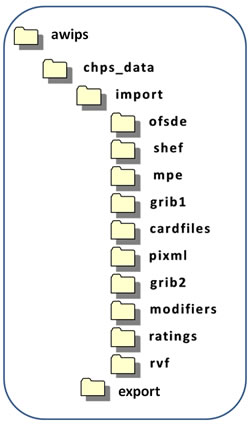4.2 Directory Structure

You must be able to navigate this directory in order to set up new inputs, configure outputs, and locate log files.
The chps_data directory structure looks similar to the image on the left.
Note: The information to the left is only an example. YOUR RFC may have slight variations in the file structure of your system.
ASCII (American Standard Code for Information Interchange)
ASCII is a character-encoding scheme originally based on the English alphabet. ASCII codes represent text in computers, communications equipment, and other devices that use text.
English characters are represented as numbers between 0 and 127. ASCII coding makes it possible to transfer large amounts of data quickly. ASCII has various “flavors.”
See http://www.webopedia.com/TERM/A/ASCII.html for more information.
chps_data Import Directory
Data is imported to the chps_data import directory from various sources including cooperating agencies.
The file types are generally ASCII, SHEF, GRIB, and XML files but could also be other formats.
The main types of input include IHFSDB, OFS, MPE, and Pre-Processed data. A script separates each data type into directories on the CHPS data servers.
The chps_data import directory is separated by type of data or source of data.
chps_data Output Directory
CHPS sends out several types of data, including:
- RFC Forecasts - Sent to WFOs in XML format.
- Updated Model States - Sent to WFO HydroBase as an XML file.
- Data for hindcasting or training - Stored in CHPS system as various file types.
The last output type is used in CHPS Simulations. For more information on how to configure your system for simulations, please visit the CHPS Simulation Configuration Training.
Note: Keep in mind that bringing in new data and creating data to send out requires memory. We discuss memory allocation later in this lesson.
Instructions: Click here to display regular course navigations once you have clicked on all of the links.

